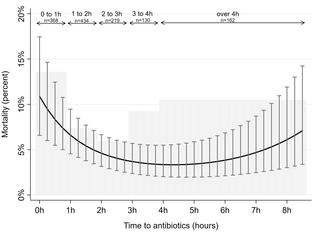Our official English website, www.x-mol.net, welcomes your
feedback! (Note: you will need to create a separate account there.)
Early diagnosis of sepsis in emergency departments, time to treatment, and association with mortality: An observational study.
PLOS ONE ( IF 2.9 ) Pub Date : 2020-01-22 , DOI: 10.1371/journal.pone.0227652 Gunnar Husabø 1, 2 , Roy M Nilsen 3 , Hans Flaatten 4 , Erik Solligård 5, 6 , Jan C Frich 7 , Gunnar T Bondevik 2, 8 , Geir S Braut 9, 10 , Kieran Walshe 11 , Stig Harthug 12, 13 , Einar Hovlid 1, 2, 10
PLOS ONE ( IF 2.9 ) Pub Date : 2020-01-22 , DOI: 10.1371/journal.pone.0227652 Gunnar Husabø 1, 2 , Roy M Nilsen 3 , Hans Flaatten 4 , Erik Solligård 5, 6 , Jan C Frich 7 , Gunnar T Bondevik 2, 8 , Geir S Braut 9, 10 , Kieran Walshe 11 , Stig Harthug 12, 13 , Einar Hovlid 1, 2, 10
Affiliation

|
BACKGROUND
Early recognition of sepsis is critical for timely initiation of treatment. The first objective of this study was to assess the timeliness of diagnostic procedures for recognizing sepsis in emergency departments. We define diagnostic procedures as tests used to help diagnose the condition of patients. The second objective was to estimate associations between diagnostic procedures and time to antibiotic treatment, and to estimate associations between time to antibiotic treatment and mortality.
METHODS
This observational study from 24 emergency departments in Norway included 1559 patients with infection and at least two systemic inflammatory response syndrome criteria. We estimated associations using linear and logistic regression analyses.
RESULTS
Of the study patients, 72.9% (CI 70.7-75.1) had documented triage within 15 minutes of presentation to the emergency departments, 44.9% (42.4-47.4) were examined by a physician in accordance with the triage priority, 44.4% (41.4-46.9) were adequately observed through continual monitoring of signs while in the emergency department, and 25.4% (23.2-27.7) received antibiotics within 1 hour. Delay or non-completion of these key diagnostic procedures predicted a delay of more than 2.5 hours to antibiotic treatment. Patients who received antibiotics within 1 hour had an observed 30-day all-cause mortality of 13.6% (10.1-17.1), in the timespan 2 to 3 hours after admission 5.9% (2.8-9.1), and 4 hours or later after admission 10.5% (5.7-15.3).
CONCLUSIONS
Key procedures for recognizing sepsis were delayed or not completed in a substantial proportion of patients admitted to the emergency department with sepsis. Delay or non-completion of key diagnostic procedures was associated with prolonged time to treatment with antibiotics. This suggests a need for systematic improvement in the initial management of patients admitted to emergency departments with sepsis.
中文翻译:

急诊科败血症的早期诊断,治疗时间以及与死亡率的关系:一项观察性研究。
背景技术败血症的早期识别对于及时开始治疗至关重要。这项研究的第一个目标是评估在急诊科中识别败血症的诊断程序的及时性。我们将诊断程序定义为用于帮助诊断患者状况的测试。第二个目标是估计诊断程序与抗生素治疗时间之间的关联,并估计抗生素治疗时间与死亡率之间的关联。方法这项来自挪威24个急诊科的观察性研究包括1559例感染患者和至少两个全身性炎症反应综合征标准。我们使用线性和逻辑回归分析来估计关联。结果在研究的患者中,有72.9%(CI 70.7-75。1)在向急诊科就诊后的15分钟内已记录了分类情况,医生根据分类优先级对44.9%(42.4-47.4)进行了检查,并通过持续监测征象充分观察了44.4%(41.4-46.9)在急诊科中,有25.4%(23.2-27.7)在1小时内收到了抗生素。这些关键诊断程序的延迟或未完成预示着抗生素治疗的延迟将超过2.5小时。在1小时内接受抗生素治疗的患者,其30天全因死亡率在入院后2至3小时内为5.9%(2.8-9.1),入院后4小时或更晚时为13.6%(10.1-17.1)。 10.5%(5.7-15.3)。结论在进入脓毒症急诊科的患者中,有很大一部分认识到败血症的关键程序被延迟或未完成。关键诊断程序的延迟或未完成与抗生素治疗时间的延长有关。这表明需要系统地改善败血症急诊患者的初始治疗。
更新日期:2020-01-23
中文翻译:

急诊科败血症的早期诊断,治疗时间以及与死亡率的关系:一项观察性研究。
背景技术败血症的早期识别对于及时开始治疗至关重要。这项研究的第一个目标是评估在急诊科中识别败血症的诊断程序的及时性。我们将诊断程序定义为用于帮助诊断患者状况的测试。第二个目标是估计诊断程序与抗生素治疗时间之间的关联,并估计抗生素治疗时间与死亡率之间的关联。方法这项来自挪威24个急诊科的观察性研究包括1559例感染患者和至少两个全身性炎症反应综合征标准。我们使用线性和逻辑回归分析来估计关联。结果在研究的患者中,有72.9%(CI 70.7-75。1)在向急诊科就诊后的15分钟内已记录了分类情况,医生根据分类优先级对44.9%(42.4-47.4)进行了检查,并通过持续监测征象充分观察了44.4%(41.4-46.9)在急诊科中,有25.4%(23.2-27.7)在1小时内收到了抗生素。这些关键诊断程序的延迟或未完成预示着抗生素治疗的延迟将超过2.5小时。在1小时内接受抗生素治疗的患者,其30天全因死亡率在入院后2至3小时内为5.9%(2.8-9.1),入院后4小时或更晚时为13.6%(10.1-17.1)。 10.5%(5.7-15.3)。结论在进入脓毒症急诊科的患者中,有很大一部分认识到败血症的关键程序被延迟或未完成。关键诊断程序的延迟或未完成与抗生素治疗时间的延长有关。这表明需要系统地改善败血症急诊患者的初始治疗。











































 京公网安备 11010802027423号
京公网安备 11010802027423号